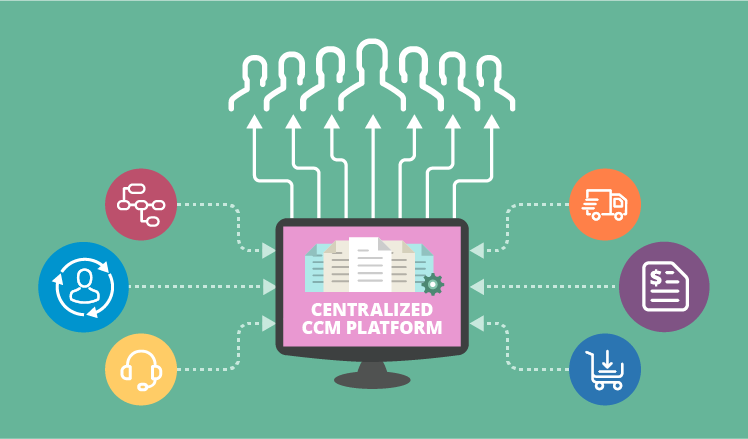Benefits of managing customer communications in a single system
Such highly competitive industries as banking, insurance and telecoms tend to focus on delivering an exceptional customer experience by cultivating high-quality customer communications (CC). Competing businesses are aware that even small missteps in a dialogue may result in losing customers to a rival company. Forrester Consulting claims that business-to-consumer (B2C) organizations name outbound communications as their top means to improve customer service. But very often in attempts to ensure individually tailored CC, businesses just increase the number of disparate customer-related software they use, which makes real-time communication next to impossible. Instead, companies can focus on a completely different approach, that’s consolidating all customer communications within a single solution.

The evolution of customer communications
Customer communications have come a long way from that old-school approach of sending printed documents to stay in touch with customers. At first, marketing and transactional communications were completely separate business processes. Marketing teams were in charge of sending promotions while financial units issued documents on customer transactions with the company. Moreover, customers’ bills and statements were all plain and ordinary text delivered straight from the machine without applying any consumer-pleasing document design.
These days the customer communications landscape is expanding by leaps and bounds. In the course of time, CC have noticeably progressed, since businesses started implementing technological advances such as automated color printing, digital data transmission and CRM systems allowing businesses to send targeted messages electronically.
The challenges of managing customer communications
Gartner divides the system of customer communications into the following segments:
1. Structured output, e.g. telephone and Internet bills, utility bills, credit card, bank, mortgage statements, etc. created at recurrent intervals. Companies usually produce large batches of documents ready to be sent at a time.
2. Interactive output, e.g. business correspondence, customer correspondence, group insurance policies, derivative contracts, etc. with customer data included into preset templates. Such documents require some business-side control to insert and check variables.
3. On-demand output, e.g. account notices, online statements, travel itineraries, welcome kits, online quotes, order confirmations, etc. in case they are initiated by sales agents or customer service representatives. This output is triggered after a person creates a request by web, phone, email, etc.
While communicating with customers, companies may face various document output challenges:
- changing information about the company
- changing a company’s brand book
- adding marketing messages to transactional documents
- aligning the voice and tone across all channels and document types
- sending documents via multiple channels
- sending paper documents in envelopes
- archiving, etc.
In the absence of a centralized customer communications system, companies need to allocate more resources to support separate systems, and any data change implies the same change to every document template, leading to a loss of time. To address all mentioned issues, companies require complex solutions to apply changes and keep up a sustainable dialogue across the entire customer communications system.
Why running separate CC solutions is not an option
Supporting consistent customer communications, especially in document-intensive organizations of telecom, banking or insurance industries, may become a real nightmare. For example, a telecom company can use around 600 document templates designed to manage and deliver content to customers. Besides, most customer-centric enterprises store customer data, document templates and elements such as logos in separate solutions. In their study Building an Agile Communications Strategy, Oracle analysts estimate that organizations may have 5-8 document automation solutions to manage customer relations! Such a disparity results in delayed adjustments and subsequent difficulties in providing rapid and relevant communications.
Forrester gives a dramatic example when a credit card company spent 162 days to make a change to a letter involving 3 different teams of people! With customers expecting real-time communication, such business processes are impermissible.
This scenario could happen since there was no centralized system to produce and manage customer communications. To tackle the problems arising from scattered B2C information flows, companies should consider using Customer Communications Management (CCM) solutions.
How customer communications management solutions help
CCM helps to improve customer experience through personalized communication managed within one solution. With it, a company can ensure a customer-centric and multi-channel dialogue built upon automated generation of outgoing documents. One of the leaders in providing the CCM functionality, OpenText Communications Center Enterprise (or OpenText StreamServe), integrates separate B2C communication flows, therefore creating an in-depth view of all customers. To support a successful dialogue with customers, StreamServe tools allow creating tailored documents that can be delivered through any channel. As CCM solutions can be integrated with ERP, CRM and other customer-related systems, these documents can include cross/up-sell offers, dynamic charts and graphs based on personal customer data.
Conclusion
By implementing a CCM platform, companies can focus on creating holistic customer experience while keeping control of all outgoing communications. Any changes in communications, communication strategies or channels will be made faster as they happen within only one single platform. By embracing a complete view of the customer in one place, companies can bring their outbound communications to a new level.

